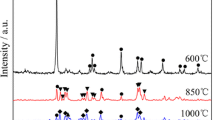Abstract
A fast and economical route based on an efficient microwave-induced solid-state process has been developed to synthesize metastable TiO2(B) nanobelts with widths of 30–100 nm and lengths up to a few micrometers on a large scale. This new method reduces the synthesis time for the preparation of TiO2(B) nanobelts to less than half an hour, allowing the screening of a wide range of reaction conditions for optimizing and scaling up the production and facilitating the formation of metastable phase TiO2(B). The as-formed TiO2(B) nanobelts exhibit enhanced lithium-storage performances, compared with the TiO2(B) product obtained by the conventional heating. This study provides a new way for large-scale industrial production of high-quality metastable TiO2(B) nanostructures. The products were characterized by X-ray diffraction, scanning electron microscopy, transmission electron microscopy, and Raman spectroscopy.








Similar content being viewed by others
References
Armstrong AR, Armstrong G, Canales J, Bruce PG (2004) TiO2-B nanowires. Angew Chem Int Ed 43:2286–2288
Armstrong AR, Armstrong G, Canales J, García R, Bruce PG (2005) Lithium-ion intercalation into TiO2-B nanowires. Adv Mater 17:862–865
Ben Yahia M, Lemoigno F, Beuvier T, Filhol JS, Richard-Plouet M, Brohan L, Doublet ML (2009) Updated references for the structural, electronic, and vibrational properties of TiO2(B) bulk using first-principles density functional theory calculations. J Chem Phys 130:204501-1–204501-11
Beuvier T, Richard-Plouet M, Brohan L (2009) Accurate methods for quantifying the relative ratio of anatase and TiO2(B) nanoparticles. J Phys Chem C 113:13703–13706
Beuvier T, Richard-Plouet M, Mancini-Le Granvalet M, Brousse T, Crosnier O, Brohan L (2010) TiO2(B) nanoribbons as negative electrode material for lithium ion batteries with high rate performance. Inorg Chem 49:8457–8464
Bruce PG, Scrosati B, Tarascon JM (2008) Nanomaterials for rechargeable lithium batteries. Angew Chem Int Ed 47:2930–2946
Gerbec JA, Magana D, Washington A, Strouse GF (2005) Microwave-enhanced reaction rates for nanoparticle synthesis. J Am Chem Soc 127:15791–15800
Hong ZS, Wei MD, Deng QX, Ding XK, Jiang LL, Wei KM (2009) A new anode material made of Zn2Ti3O8 nanowires: synthesis and electrochemical properties. Chem Commun 46:740–742
Hong ZS, Zheng XZ, Ding XK, Jiang LL, Wei MD, Wei KM (2011) Complex spinel titanate nanowires for a high rate lithium-ion battery. Energy Environ Sci 4:1886–1891
Hosono E, Kudo T, Honma I, Matsuda H, Zhou H (2009) Synthesis of single crystalline spinel LiMn2O4 nanowires for a lithium ion battery with high power density. Nano Lett 9:1045–1051
Hu XL, Yu JC (2008) Continuous aspect-ratio tuning and fine shape control of monodisperse α-Fe2O3 nanocrystals by a programmed microwave-hydrothermal method. Adv Funct Mater 18:880–887
Hu XL, Yu JC, Gong JM, Li Q, Li GS (2007) α-Fe2O3 nanorings prepared by a microwave-assisted hydrothermal process and their sensing properties. Adv Mater 19:2324–2329
Hu XL, Gong JM, Zhang L, Yu JC (2008) Continuous size tuning of monodisperse ZnO colloidal nanocrystal clusters by a microwave-polyol process and their application for humidity sensing. Adv Mater 20:4845–4850
Komarneni S (2004) Nanophase materials by hydrothermal, microwave hydrothermal and microwave-solvothermal methods. Curr Sci 85:1730–1734
Liu B, Aydil ES (2009) Growth of oriented single-crystalline rutile TiO2 nanorods on transparent conducting substrates for dye-sensitized solar cells. J Am Chem Soc 131:3985–3990
Liu AH, Wei MD, Honma I, Zhou HS (2006) Biosensing properties of titanate-nanotube films: selective detection of dopamine in the presence of ascorbate and uric acid. Adv Funct Mater 16:371–376
Marchand R, Brohan L, Tournoux M (1980) TiO2(B) a new form of titanium dioxide and the potassium octatitanate K2Ti8O17. Mater Res Bull 15:1129–1133
Wang Y, Du G, Liu H, Liu D, Qin S, Wang N, Hu C, Tao X, Jiao J, Wang J (2008) Nanostructured sheets of Ti-O nanobelts for gas sensing and antibacterial applications. Adv Funct Mater 18:1131–1137
Wessel C, Zhao L, Urban S, Ostermann R, Djerdj I, Smarsly BM, Chen L, Hu Y, Sallard S (2011) Ionic-liquid synthesis route of TiO2(B) nanoparticles for functionalized materials. Chem A Eur J 17:775–779
Xiang G, Li T, Zhuang J, Wang X (2010) Large-scale synthesis of metastable TiO2(B) nanosheets with atomic thickness and their photocatalytic properties. Chem Commun 46:6801–6803
Xiao W, Chen JS, Li CM, Xu R, Lou XW (2009) Synthesis, characterization, and lithium storage capability of AMoO4 (A = Ni, Co) nanorods. Chem Mater 22:746–754
Zhang H, Li GR, An LP, Yan TY, Gao XP, Zhu HY (2007) Electrochemical lithium storage of titanate and titania nanotubes and nanorods. J Phys Chem C 111:6143–6148
Zhao ZG, Miyauchi M (2008) Nanoporous-walled tungsten oxide nanotubes as highly active visible-light-driven photocatalysts. Angew Chem Int Ed 120:7159–7163
Zhu YJ, Wang WW, Qi RJ, Hu XL (2004) Microwave-assisted synthesis of single-crystalline tellurium nanorods and nanowires in ionic liquids. Angew Chem Int Ed 43:1410–1414
Zukalová M, Kalbác M, Kavan L, Exnar I, Graetzel M (2005) Pseudocapacitive lithium storage in TiO2(B). Chem Mater 17:1248–1255
Acknowledgments
This study was supported by the Natural Science Foundation of China (Grant Nos. 51002057 and 50825203), the 863 program (Grant No. 2009AA03Z225), the Natural Science Foundation of Hubei Province (Grant No. 2008CDA026), the PCSIRT (Program for Changjiang Scholars and Innovative Research Team in University), and the Fundamental Research Funds for the Central Universities (HUST: 2010QN007). The authors thank Analytical and Testing Center of HUST for XRD, Raman, SEM, and TEM measurements.
Author information
Authors and Affiliations
Corresponding author
Rights and permissions
About this article
Cite this article
Qiao, Y., Hu, X. & Huang, Y. Microwave-induced solid-state synthesis of TiO2(B) nanobelts with enhanced lithium-storage properties. J Nanopart Res 14, 684 (2012). https://doi.org/10.1007/s11051-011-0684-5
Received:
Accepted:
Published:
DOI: https://doi.org/10.1007/s11051-011-0684-5




